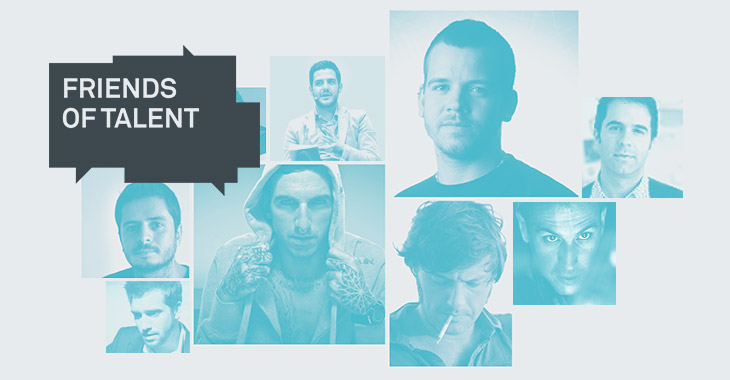Conferencias
«Friends of Talent» meetings
«Friends of Talent» meetings

This way, every “Friends of Talent” get-together becomes an informal gathering among young people, for young people, to prove that success is not at odds with age, nationality, or profession. While open to the public, “Friends of Talent” is especially aimed at young people between 18 and 35 years of age who are interested in developing their professional career without giving up on their talent and personality, who are eager to find their place in the job market, to plot their own professional path, to learn about new ways of doing what they like, to understand how to leverage their talent and potential, to discover that it is possible to succeed despite the current economic/unemployment situation, and to understand that each challenge can become an opportunity.
One of the main goals of the “Friends of Talent” meetings is to highlight the creative and entrepreneurial potential of young people in Spain, as well as to eradicate mistaken prejudices regarding age, nationality and professional/artistic field.
Meeting in March 2013
Mayte Carrasco and Samuel Aranda
About the meeting:
Ninth session of the meeting cycle.
¿Can professional stability be achieved as a freelancer? ¿Is the profession of the journalist regarded favourably? ¿Is there anything left to invent in this sector? Reporter Mayte Carrasco and photojournalist Samuel Aranda, both specialising in armed conflict, will address these questions and more. They will both be taking part in the “Friends of Talent” get-together to be held on 5 March at the Espacio Fundación Telefónica Auditorium at 7 pm.
«Friends of Talent» meetings

Mayte Carrasco, aged 38, is a freelance reporter, analyst and teacher. She received a prize for best foreign correspondent in 2011 from the International Press Club (CIP), was a finalist for the Cirilo Rodriguez 2012 War Correspondents Prize and received Mare Terra special mention at the Fundació Mediterrani Ones Awards for her professional career. She has worked as a correspondent in France and Russia and has been covering armed conflict for some years now, collaborating with national and international media such as iTELE-Canal Plus (France), El País, Público, La Nación, DPA (Germany), DIE WELT (Germany), Cadena SER, Yo Dona, Informativos Telecinco, Foreign Policy – Spanish Edition, La Nación, Opendemocracy (UK), and more. She produces, shoots and edits her own work.
Some of her latest coverage includes the Arab uprisings. She spent a month and a half in July and August in the provinces of Homs and Damascus (Siria), and a month in Homs in February during the Baba Amro offensive. She was in Tripoli during the war in Libya (one month under the reign and fall of Gadafi in August). She spent some time in rebel territory in Libya and witnessed the drama of the refugees on the Ras Ajdir border between Tunisia and Libya, as well as the Egyptian revolution in Cairo. Other: She also covered the Dirty War in the North Caucasus (Chechnya, Ingushetia); the hijacking and terrorism of Al Qaeda in the Sahel desert (in northern Mali); the war between Russia and Georgia in 2008; and the conflict in Afghanistan in 2009-2010, where she travels often. She previously spent several years working as a correspondent in Paris and Moscow for the Spanish channels Cuatro, Punto Radio and Informativos Telecinco, providing in-depth, current-event coverage on both countries, and also for the multilingual channel, Euronews, in 2004.
http://www.maytecarrasco.com/bio.php
«Friends of Talent» meetings

Samuel Aranda, born in Santa Coloma de Gramanet in 1979, began his career in photojournalism at the age of 19 for the El País and El Periódico de Catalunya newspapers. At the age of 21 he covered the conflict between Israel and Palestine for Agencia EFE. In 2004 he joined Agencia France Presse, for which he photographed many conflicts in Spain, Pakistan, the Gaza Strip, Lebanon, the Palestinian Territories, Morocco, Western Sahara and China. In 2006 his project about African emigrants trying to reach Europe won the National Photography Prize. That same year, he went back to working as a freelance photojournalist on projects about the Aral Sea in Uzbekistan, social problems in India, the independence of Kosovo, South Africa before the UEFA World Cup, the conflict in Colombia, the dispute between Moldova and Transnistria, street children in Bucharest and the Camorra in Naples. In 2011, he began to cover the Arab uprisings in Tunisia, Egypt, Libya and Yemen, a project which he has put on display in the Cervantes Institute of New York and which was selected as one of the “photos of the year” by The New York Times. He received the World Press Photo 2012 award for an image of the revolution in Yemen. He is currently working as a freelancer, mostly for The New York Times.
http://www.samuelaranda.net/